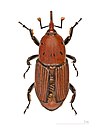Hugu (instrument)
 From Wikipedia the free encyclopedia
From Wikipedia the free encyclopedia
 | |
| Other instrument | |
|---|---|
| Developed | as a local custom, among Onabasulu people of southern highlands of Papua New Guinea, and the Telefomin area |
A hugu is a sago-palm weevil (Rhynchophorus ferrugineus) in Papua New Guinea that has been used by men of the Onabasulu people as a musical instrument. The musicians pin the beetle onto a sharpened stick and hold the beetle up to their mouths, spinning the stick and beetle. If they do this during daylight, the beetle will beat its wings and provide a buzzing sound. The musicians' mouths act as a variable resonance chamber, in the same way as it does for a musician playing a Jew's harp or musical bow.[1][2] By opening and closing their mouths and changing the shape, musicians can raise and lower the pitch, and make the music louder or softer.[3]
This technique has been documented and made available by ethnomusicologists.[4]
References
[edit]- ^ Eraldo Medeiros Costa-Neto (2003). "Entertainment with insects: singing and fighting insects around the world. A brief review" (PDF). Etnobiología. 3. Asociación Etnobiológica Mexicana AC (AEM): 21–29. Retrieved 30 January 2021.
- ^ Victor Benno Meyer-Rochow; Kenichi Nonaka; Somkhit Boulidam (2008). "More Feared than Revered: Insects and their Impact on Human Societies (with some Specific Data on the Importance of Entomophagy in a Laotian Setting)" (PDF). Entomologie Heute (Translation: Entomology Today). 20. Freundeskreis Aquazoo Löbbecke Museum: 6, 8–9.
The use of the weevil Rhynchophorus ferrugineus or, to be precise, its buzz as a musical instrument (Fig. 2), amongst the men folk of the Onabasulu cannibals of the southern highlands of Papua New Guinea has been documented by MEYER-ROCHOW (1973a, 1982b) and is also known from tribals in the Telefomin area of New Guinea.
- ^ V. Benno Meyer-Rochow (January 1978). "The diverse uses of insects in traditional societies". Ethnomedizin (Ethnomedicine). Hamilton, New Zealand: Department of Biological Sciences, University of Waikato: 291.
- ^ Zemp, Hugo (1996). "CD 2, track 33, recorded by B. Juillerat". Les Voix Du Monde - Une Anthologie Des Expressions Vocales. Paris, France: Musée de l'Homme. pp. 155, 156.